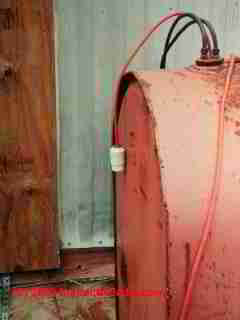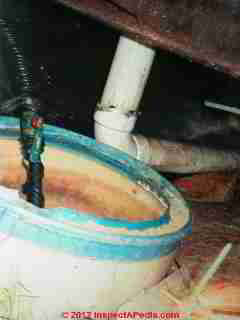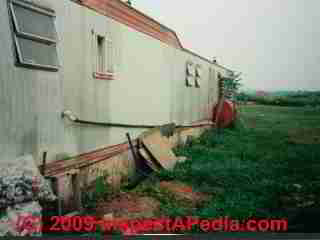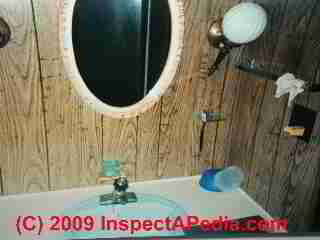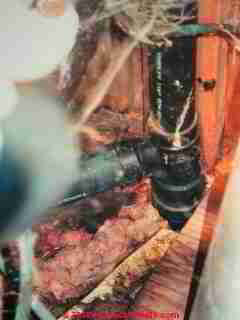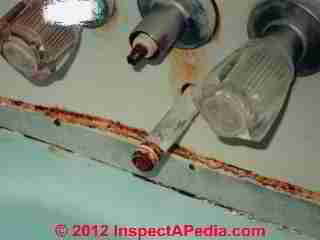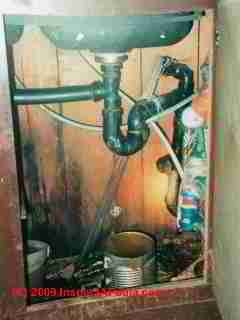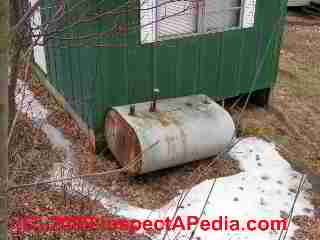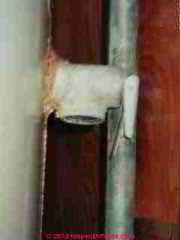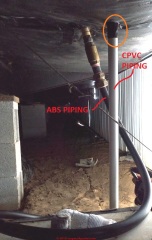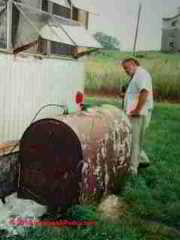 Inspect the Plumbing Systems of Mobile Homes, Double wides, Trailer homes
Inspect the Plumbing Systems of Mobile Homes, Double wides, Trailer homes
- POST a QUESTION or COMMENT about mobile home & double-wide plumbing systems: inspection, diagnosis, repair, or replacement of mobile home plumbing
How to Inspect Mobile Homes or Manufactured Housing for Plumbing System Defects:
Detailed mobile home, trailer or doublewide plumbing inspection procedures, defect lists, references to plumbing standards for mobile homes, trailers, double-wide home plumbing water supply & drain piping and oil or gas fuel piping.
Mobile home septic systems are also addressed.
InspectAPedia tolerates no conflicts of interest. We have no relationship with advertisers, products, or services discussed at this website.
- Daniel Friedman, Publisher/Editor/Author - See WHO ARE WE?
Doublewide, Mobile Home (Caravan) or Trailer Plumbing System Defects & Hazards
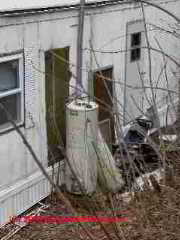 Mobile home & manufactured home plumbing standards, codes, defects & repairs.
Mobile home & manufactured home plumbing standards, codes, defects & repairs.
Article Contents:
Ver.4.0 - 04/25/07, updated through May 2022 - Steve Vermilye, New Paltz NY and Daniel Friedman, Poughkeepsie NY, Hudson Valley ASHI Chapter Seminar, Newburgh NY, January 4, 2000, NY Metro ASHI Fall 99 Seminar, Holiday Inn Crowne Plaza, White Plains NY, October 2, 1999. Our page top photo shows our associated Steve Vermilye inspecting an on-ground, tipping, heating oil tank at a mobile home occupied by farm workers in Ulster County, N.Y.
GENERAL PLUMBING - Comments for Mobile Home Inspectors
- 36% of mobile homes report problems with plumbing (C. R. survey)
- most common complaint according to C. r. - 1/3 homes have problems;
- Low quality sinks, tubs, showers, faucets (molded plastic faucets, fixtures; porcelain or acrylic preferred)
- no shutoff valves especially at toilets in mobile homes and trailers
- leaks damage structure, especially with use of particle board sub flooring.
SUPPLY PIPING - Mobile Home Supply Piping Defects and Plastic or polybutylene water supply piping failures, leaks, and litigation
- PB (polybutylene with mechanical fittings) Piping leaks:
especially in South, for example trailers and double-wides throughout Florida that were piped with this material - per M Cramer. See "Polybutylene Piping: Time Bomb?" Daniel Friedman, Journal of Light Construction, August 1996 [Technical Q&A]. - Plastic Supply and Drain Piping Failures:
leaks, LAWSUITS & SETTLEMENTS
- If plastic water piping is installed:
such as polybutylene water supply piping, it should be at least 18" from the water heater. - New mobile home and trailer units:
3/4" supply piping, min 6" off ground; shutoff valve required;
Freeze Protection Suggestions for Mobile Homes, Double-Wides and Trailers:
- Note on use of heat tapes on plumbing or oil piping:
The US CPSC recommends that heat tapes be connected to a GFCI-protected electrical receptacle (or on newer wired-installations AFCI circuits) for fire safety but HUD rules do not allow connection of the heat tape to GFCI because they don't want to risk frost damage: so note conflict between frost damage and life-safety concerns.
Heat tapes used on exposed plumbing at extra risk of freezing, e.g. below the units. - If mobile home supply piping has frozen, burst, and leaked into the structure,
you'll need to remove and discard any wet insulation - or else face a mold problem. - Simply adding insulation, in any amount is by itself unlikely to be sufficient
to protect a mobile home from freezing if it's left unattended with heat off. Rather people design the plumbing to be drained when the home is left. - If the trailer or mobile the home is occupied
then you'll need to look carefully at supply pipe routing and maybe even add heat in some areas. We dislike heat tapes - as they can be unreliable and possible fire hazards, but they can work in some cases.
High-quality plumbing pipe heating tapes that can be crossed over one another without melting and shorting out (fire hazard) are available.
Of course if the home loses electrical power this solution won't help much. To reduce the mobile home fire risk when using heat tapes, use metal-braid shielded heating cables connected to a GFCI protected electrical outlet so that if the heating tapes short out the circuit will trip.
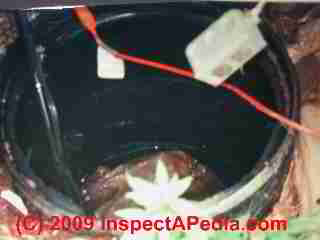 ...
... 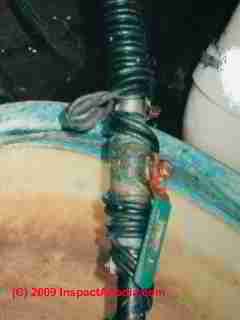
- Trailer & mobile home water entry lines (and some drains) are often exposed to freezing below the unit - (photos at left and above left and right).
- If the mobile home water supply is provided by a pump
and the pump is found to have cracked (and the home is located in a climate where freezing weather occurs, pump cracking probably means it froze and was not drained or protected from freezing. - If mobile home drains are freezing
the same frost protection or heating concerns need to be addressed as we've just listed. - Open drains or leaky connections (crawl)
- Leaky supply main (crawl)
DRAIN WASTE VENT - Mobile Home & Trailer Drain Waste Vent Piping Defects
- In freezing climates,
failure to protect water supply piping (& drain traps) from freezing. If you see supply piping with a stunning number of small parts and solder joints and repairs (photo at left) that may indicate a history of frozen pipes in that unit.
- Heat Tapes -
use metal-braid shielded type connected to GFCI so if there is an electrical short the circuit breaker will trip or fuse will blow - Plumbing drains added
(added laundry or bath) not under unit or ? (photo at above left shows a laundry drain spilling onto the yard surface by the mobile home) - Leaky traps rot walls and floors faster
than conventional construction especially where OSB or chipboard was used for subfloor material in the mobile home or trailer
Our photos (above and below) illustrate an area of plumbing drain leaks below the sink in a doublewide home - rot destroyed the subfloor, invited carpenter ants into the structure, and soaked insulation.
- Plumbing fixtures with non-functional
and / or inadequate parts such as these leaky tub/shower controls and missing tub spout in a mobile home. - Look for plumbing leaks
into the crawl area; - Look for proper plumbing drain slope 1/8" /ft,
and support (no less than 4ft o.c.), and - Check the direction of plumbing fittings,
and proper adhesive (DWV for PVC, ABS or both); - Damaged plumbing fixtures, leaky sink traps, unsafe electrical receptacles or no GFCI's in bathrooms and kitchens -
our photo at below left shows a leaky sink, improper (down-sloping) drain connection to a laundry at left of the sink tailpiece, and leaks that have created a mold problem in this mobile home.
- Amateur plumbing work and leaks leading to structural damage -
photos above and below show the value of finding access to tub and shower plumbing and a history of leaks.
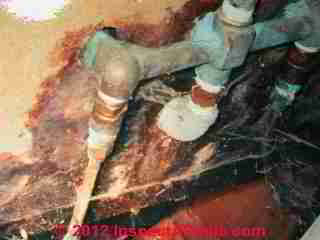
Mobile Home & Trailer Or Double-wide Heating Fuel Supply Defects & Concerns, Gas And Oil Piping
- Mobile home and trailer gas piping:
crossover flex connector at mate line of adjacent units - LP tank or oil tank location -
per manufacturer and code; - Gas and oil shutoffs required per usual locations -
at but not inside the appliance cover - Gas meter base:
if a gas meter is installed, the manufacturer may specify the minimum distance from the gas inlet; because installation is done on limited budget it's often by people who are not trained and don't know these or other safety requirements - Gas piping supplying LP gas
to the mobile home, trailer, or double-wide home is often not protected from damage (photo at left - Steve Vermilye)
Warnings about using heat tapes on mobile home water or drain pipes or on heating oil lines
Heat Tapes - use metal-braid shielded type connected to GFCI so if a short will trip. Heat tapes, especially the non-shielded types, short and start fires, especially if crossed over themselves or otherwise improperly installed.
Mobile home oil tank defects, problems, repairs
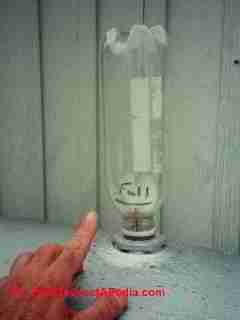
- Oil tank support
(often falling or in ground-contact) see our photo at page top - Oil tank gauges and fill and vent piping -
exposed to water entry from roof spillage or, as in our photo, from a makeshift repair to a fuel gage or other tank connection
Mobile Home Water Heaters: install, inspect, repair, codes
Moved to MOBILE HOME WATER HEATERS
Plumbing Defects & Safety Hazards in Mobile Homes, Trailers, Double-Wides
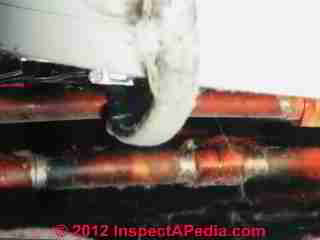
- In freezing climates, failure to protect water supply piping (& drain traps) from freezing.
If you see supply piping with a stunning number of small parts and solder joints and repairs (photo at left) that may indicate a history of frozen pipes in that unit. - Heat Tapes -
use metal-braid shielded type connected to GFCI so if there is an electrical short the circuit breaker will trip or fuse will blow - Gas-fired water heater located in in sleeping areas
- Gas or oil fired water heaters in a tight utility closet
without adequate combustion air - Electric (usually) water heaters
often with bad wiring connections - Water heater located outdoors
(not a location supported by the equipment) (photo below left)
 ...
... 
- Plumbing valves, pipes, not protected from freezing
- Water heaters located in closets
accessed only from outside, never inspected, heaters leaky or unsafe because the water heater has tipped on a rotting floor (photo at below left)
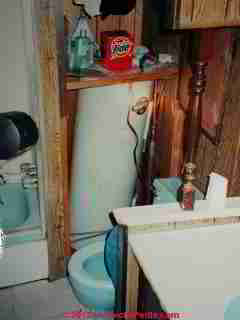
- Water heater relief valves in mobile homes:
to hidden location (below trailer, can't see leaks), and usual issues of down-sized pipes or missing discharge tube on relief valve
- Improper water heater exhaust venting,
risk dangerous carbon monoxide leaks into the interior -
see CARBON MONOXIDE - CO
MOBILE HOME PLUMBING Fixture Defects
- Tubs:
usual leaks at fittings, missing components - History of leaks
and no maintenance - Fixtures or fixture drains
damaged from freezing underneath the home in cold climates
Manufactured / Mobile Home Plumbing Codes & Standards
- PART 3280—MANUFACTURED HOME CONSTRUCTION AND SAFETY STANDARDS [PDF] Complete text of 24 CFR Part 3280 - MANUFACTURED HOME CONSTRUCTION AND SAFETY STANDARDS contains 10 subparts pertaining to General (data plate and certification contents and locations), Plans (dimensions, exits, etc), Fire Safety, Body and Frame, Testing, Thermal Protection, Heating/Cooling and venting systems, Electrical, and Transportation (axles, springs, drawbar). It's about 90 pages of regulations.
Excerpts from Subpart G - Plumbing Systems (§§ 3280.601 - 3280.612)
§3280.603 General requirements.
(a) Minimum requirements. Any plumbing system installed in a manufactured home shall conform, at least, with the provisions of this subpart.
(1) General. The plumbing system shall be of durable material, free from defective workmanship, and so designed
and constructed as to give satisfactory service for a reasonable life expectancy.
(2) Conservation. Each water closet must not use more than 1.6 gallons of water per flush.
(3) Connection to drainage system. All plumbing, fixtures, drains, appurtenances, and appliances designed or used to receive or discharge liquid waste or sewage shall be connected to the manufactured home drainage system in a manner provided by this standard.
(4) Workmanship. All design, construction, and workmanship shall be in conformance with accepted engineering practices and shall be of such character as to secure the results sought to be obtained by this standard.
(5) Components. Plumbing materials, devices, fixtures, fittings, equipment, appliances, appurtenance, and
accessories intended for use in or attached to a manufactured home shall conform to one of the applicable standards
referenced in §3280.604. Where an applicable standard is not referenced, or an alternative recognized standard is utilized, the plumbing component shall be listed by a nationally recognized testing laboratory, inspection agency or other qualified organization as suitable for the intended use.
(6) Prohibited fittings and practices. (i) Drainage or vent piping shall not be drilled and tapped for the purpose of
making connections.
(ii) Except as specifically provided elsewhere in this standard, vent pipes shall not be used as waste or drain pipes.
(iii) Fittings, connections, devices, or methods of installation that obstruct or retard the flow of sewage, or air in the
drainage or venting systems in an amount greater than the normal frictional resistance to flow shall not be used unless
their use is acceptable in this standard or their use is accepted as having a desirable and acceptable function of ultimate
benefit to the proper and continued functioning of the plumbing system.
(iv) Cracks, holes, or other imperfections in materials shall not be concealed by welding, brazing, or soldering or by
paint, wax, tar, or other leaksealing or repairing agents.
(v) Piping, fixtures or equipment shall be located so as not to interfere with the normal use or with the normal
operation and use of windows, doors or other required facilities.
(vi) Galvanized pipe shall not be bent or welded.
(7) Alignment of fittings. All valves, pipes, and fittings shall be installed in correct relationship to the direction of flow.
(b) Protective requirements.
(1) Cutting structural members. Structural members shall not be unnecessarily or
carelessly weakened by cutting or notching.
(2) Exposed piping. All piping, pipe threads, hangers, and support exposed to the weather, water, mud, and road
hazard, and subject to damage there from, shall be painted, coated, wrapped, or otherwise protected from deterioration.
(3) Road damage. Pipes, supports, drains, outlets, or drain hoses shall not extend or protrude in a manner where they
could be unduly subjected to damage during transit.
(4) Freezing. All piping and fixtures subject to freezing temperatures shall be insulated or protected to prevent
freezing, under normal occupancy. The manufacturer shall provide:
(i) Written installation instructions for the method(s) required for compliance to this section;
(ii) A statement in the installation instructions required by §3280.306(b), stating that if the heat tape or pipe heating cable is used, it must be listed for use with manufactured homes.
(iii) A receptacle outlet complying with §3280.806(d)(10).
(5) All piping, except the fixture trap, shall be designed to allow drainage.
(6) Rodent resistance. All exterior openings around piping and equipment shall be sealed to resist the entrance of
rodents.
(7) Piping and electrical wiring shall not pass through the same holes in walls, floors or roofs. Plastic piping shall not be exposed to heat in excess of manufacturers recommendation or radiation from heat producing appliances.
[40 FR 58752, Dec. 18, 1975, as amended at 42 FR 54383, Oct. 5, 1977. Redesignated at 44 FR 20679, Apr. 6, 1979, as amended
at 58 FR 55012, Oct. 25, 1993; 78 FR 73985, Dec. 9, 2013]
§3280.605 Joints and connections.
(a) Tightness. Joints and connections in the plumbing system shall be gastight and watertight for the pressures required under testing procedures.
(b) Assembling of pipe. All joints and connections shall be correctly assembled for tightness. Pipe threads shall be
fully engaged with the threads of the fitting. Plastic pipe and copper tubing shall be inserted to the full depth of the solder
cup or welding sockets of each fitting. Pipe threads and slip joints shall not be wrapped with string, paper, putty, or similar
fillers.
(c) Threaded joints. Threads for screw pipe and fittings shall conform to the approved or listed standard. Pipe ends
shall be reamed out to size of bore. All burrs, chips, cutting oil and foreign matter shall be removed. Pipe joint cement or
thread lubricant shall be of approved type and applied to male threads only.
(d) Solder joints. Solder joints for tubing shall be made with approved or listed solder type fittings. Surfaces to be
soldered shall be cleaned bright. The joints shall be properly fluxed with noncorrosive paste type flux and, for
manufactured homes to be connected to a public water system, made with solder having not more than 0.2 percent lead.
(e) Plastic pipe, fittings and joints. Plastic pipe and fittings shall be joined by installation methods recommended by
the manufacturer or in accordance with the provisions of a recognized, approved, or listed standard.
(f) Union joints. Metal unions in water piping shall have metaltometal ground seats.
(g) Flared joints. Flared joints for softcopper water tubing shall be made with approved or listed fittings. The tubing
shall be expanded with a proper flaring tool.
(h) Cast iron soil pipe joints. Approved or listed cast iron pipe may be joined as follows:
(1) Approved or listed hubless pipe and fittings must be permitted to be joined with listed couplings or adapters, per
the manufacturer's recommendations.
(2) Hub and plainend soil pipe may be joined by compression fittings per the manufacturer's recommendation
§3280.606 Traps and cleanouts.
(a) Traps—
(1) Traps required. Each plumbing fixture, except listed toilets, shall be separately trapped by approved water seal “P” traps. All traps shall be effectively vented.
(2) Combination Fixtures. For the purposes of drainage and ventilation requirements, a two or threecompartment
sink, up to three single sinks, or up to three lavatories may be connected to one “P” trap and considered as a single
fixture, so long as the sinks and lavatories are in the same room, have waste outlets not more than 30 inches apart, and
have flood level rims at the same level. The “P” trap must be installed at the center fixture when three such fixtures are
installed.
(3) Prohibited traps. A trap which depends for its seal upon concealed interior partitions shall not be used. Full “S”
traps, bell traps, drum traps, crownvented traps, and running traps are prohibited. Fixtures shall not be doubletrapped.
(4) Material and design. Each trap shall be selfcleaning with a smooth and uniform interior waterway. Traps shall be
manufactured of cast iron, cast brass, or drawn brass tubing of not less than No. 20 Brown and Sharpe gage, or approved
or listed plastic, or other approved or listed material. Union joints for a trap shall be beaded to provide a shoulder for the
union nut. Each trap shall have the manufacturer's name stamped or cast in the body of the trap, and each tubing trap
shall show the gage of the tubing.
(5) Trap seal. Each “P” trap shall have a water seal of not less than 2 inches and not more than 4 inches and shall be
set true to its seal.
(6) Size. Traps shall be not less than 1
1
∕4
inches in diameter. A trap shall not be larger than the waste pipe to which it
is connected.
(7) Location. Each trap shall be located as close to its vent and to its fixture outlet as structural conditions will permit.
(8) Length of tailpiece. The vertical distance from a trap to the fixture outlet shall not exceed 24 inches.
(9) Installation. (i) Grade of trap arm. The piping between a “P” trap and the fixture tee or the vented waste line shall
be graded
1
∕4
inch per foot towards the vent and in no event shall have a slope greater than its diameter. The vent opening
at fixture tees shall not be below the weir of the “P” trap outlet.
(ii) Trap arm offset. The piping between the “P” trap and vent may change direction or be offset horizontally with the
equivalent of no more than 180 degrees total change in direction with a maximum of 90 degrees by any one fitting.
(iii) Concealed traps. Traps with mechanical joints shall be accessible for repair and inspection.
(iv) Removability of traps, etc. Traps shall be designed and installed so the “U” bend is removable without removing
the strainers from the fixture. Continuous waste and tail pieces which are permanently attached to the “U” bend shall also
be removable without removing the strainer from the fixture.
(b) Cleanout openings—(1) Location of cleanout fittings. (i) Cleanouts shall be installed if the drainage system cannot be cleaned through fixtures, drains, or vents. Cleanouts shall also be provided when fittings of more than 45 degrees are used to affect an offset except where long turn ells are used which provide sufficient “sweep” for cleaning.
(ii) A full size cleanout shall be installed at the upper end of any section of drain piping which does not have the
required minimum slope of
1
∕4
inch per foot grade.
(iii) A cleaning tool shall not be required to pass through more than 360 degrees of fittings, excluding removable “P”
traps, to reach any part of the drainage system. Water closets may be removed for drainage system access.
(2) Access to cleanouts. Cleanouts shall be accessible through an unobstructed minimum clearance of 12 inches
directly in front of the opening. Each cleanout fitting shall open in a direction opposite to the flow or at right angles to the
pipe. Concealed cleanouts that are not provided with access covers shall be extended to a point above the floor or outside
of the manufactured home, with pipe and fittings installed, as required, for drainage piping without sags and pockets.
(3) Material. Plugs and caps shall be brass or approved or listed plastic, with screw pipe threads.
(4) Design. Cleanout plugs shall have raised heads except that plugs at floor level shall have countersunk s...
§3280.607 Plumbing fixtures.
(a) General requirements—(1) Quality of fixtures. Plumbing fixtures shall have smooth impervious surfaces, be free
from defects and concealed fouling surfaces, be capable of resisting road shock and vibration, and shall conform in quality
and design to listed standards. Fixtures shall be permanently marked with the manufacturer's name or trademark.
(2) Strainers. The waste outlet of all plumbing fixtures, other than toilets, shall be equipped with a drain fitting that will
provide an adequate unobstructed waterway.
(3) Fixture Connections. Fixture tailpieces and continuous wastes in exposed or accessible locations must be of not
less than No. 20 Brown and Sharpe gauge seamless drawnbrass tubing or other approved pipe or tubing materials.
Inaccessible fixture connections must be constructed according to the requirements for drainage piping. The diameter of
each fixture tailpiece, continuous waste, or waste and overflow must be not less than:
(i) 1
1
∕2
inches, for sinks of two or more compartments, dishwashers, clothes washing machines, laundry tubs,
bathtubs, and showers; and
(ii) Not less than 1
1
∕4
inches for lavatories or single compartment sinks having a 2inch maximum drain opening.
(4) Concealed connections. Concealed slip joint connections shall be provided with adequately sized unobstructed
access panels and shall be accessible for inspection and repair.
(5) Directional fitting. An approved or listed “Y” or other directionaltype branch fitting shall be installed in every
tailpiece or continuous waste that receives the discharge from food waste disposal units, dishwashing, or other forcedischarge
fixture or appliance. (See also §3280.607(b)(4)(ii).)
(6) Water conservation. All lavatory faucets, showerheads, and sink faucets must not exceed a flow of 2.5 gallons per
minute (gpm).
(b) Fixtures—
(1) Spacing. All plumbing fixtures shall be so installed with regard to spacing as to be reasonably accessible for their intended use.
(2) Water closets.
(i) Water closets shall be designed and manufactured according to approved or listed standards
and shall be equipped with a water flushing device capable of adequately flushing and cleaning the bowl at each operation
of the flushing mechanism.
(ii) Water closet flushing devices shall be designed to replace the water seal in the bowl after each operation. Flush
valves, flushometer valves, flushometer tanks and ballcocks shall operate automatically to shut off at the end of each flush
or when the tank is filled to operating capacity.
(iii) All water closets must be low consumption (1.6 gallons per flush (gpf)) closets.
(iv) Flush tanks shall be fitted with an overflow pipe large enough to prevent flooding at the maximum flow rate of the
ball cock. Overflow pipes shall discharge into the toilet, through the tank.
(v) Floor Connection. Water closets must be securely bolted to an approved flange or other approved fitting that is secured to the floor by means of corrosionresistant screws.
The bolts must be of solid brass or other corrosionresistant
material and must not be less than
1
∕4
inch in diameter. A watertight seal must be made between the water closet and
flange or other approved fitting by use of a gasket, sealing compound, or listed connector device.
(vi) Floor connection. Water closets shall be securely bolted to an approved flange or other approved fitting which is
secured to the floor by means of corrosionresistant screws. The bolts shall be of solid brass or other corrosionre... material and shall be not less than onefourth inch in diameter. A watertight seal shall be made between the water closet
and flange or other approved fitting by use of a gasket or sealing compound.
(3) Shower compartment. (i) Each compartment stall shall be provided with an approved watertight receptor with sides and back extending at least 1 inch above the finished dam or threshold. In no case shall the depth of a shower receptor be less than 2 inches or more than 9 inches measured from the top of the finished dam or threshold to the top of the drain.
The wall area shall be constructed of smooth, noncorrosive, and nonabsorbent waterproof materials to a height not less
than 6 feet above the bathroom floor level. Such walls shall form a watertight joint with each other and with the bathtub,
receptor or shower floor. The floor of the compartment shall slope uniformly to the drain at not less than onefourth nor
more than onehalf inch per foot.
(ii) The joint around the drain connection shall be made watertight by a flange, clamping ring, or other approved listed
means.
(iii) Shower doors and tub and shower enclosures shall be constructed so as to be waterproof and, if glazed, glazing
shall comply with the Standard for Safety Glazing Materials used in Buildings—Safety Performance Specifications and
Methods of Test, ANSI Z97.12004 (incorporated by reference, see §3280.4).
(iv) Prefabricated plumbing fixtures shall be approved or listed.
(v) Shower and tubshower combination valves must be balanced pressure, thermostatic, or combination mixing valves that conform to the requirements of ASSE 10162005, Performance Requirements for Automatic Compensating Valves for Individual Shower and Tub/Shower Combinations (incorporated by reference, see §3280.4).
Such valves must
be equipped with handle position stops that are adjustable in accordance with the valve manufacturer's instructions and to
a maximum setting of 120 °F. Hot water supplied to bathtubs and whirlpool bathtubs are to be limited to a temperature of
not greater than 120 °F by a water temperature limiting device that conforms to the requirements of ASSE 10702004,
Performance Requirements for Water Temperature Limiting Devices (incorporated by reference, see §3280.4).
(4) Dishwashing machines. (i) A dishwashing machine must discharge its waste through a fixed air gap installed above the machine, through a high loop as specified by the dishwashing machine manufacturer, or into an open standpipe receptor with a height greater than the washing compartment of the machine. When a standpipe is used, it must be at least 18 inches, but not more than 30 inches, above the trap weir. The drain connections from the air gap or high loop are permitted to connect to an individual trap to a directional fitting installed in the sink tailpiece or to an opening provided on the inlet side of a food waste disposal unit.
(ii) Drain from a dishwashing machine shall not be connected to a sink tailpiece, continuous waste line, or trap on the
discharge side of a food waste disposal unit.
(5) Clothes washing machines. (i) Clothes washing machines shall drain either into a properly vented trap, into a
laundry tub tailpiece with watertight connections, into an open standpipe receptor, or over the rim of a laundry tub.
(ii) Standpipes must be either 1 1 ∕2 inch diameter minimum nominal iron pipe size, 1 1 ∕2 inch diameter nominal brass tubing of not less than No. 20 Brown and Sharp gauge, or 1 1∕2 inch diameter approved plastic materials.
Receptors must
discharge into a vented trap or must be connected to a laundry tub appliance by means of an approved or listed directional
fitting. Each standpipe must extend not less than 18 inches or more than 42 inches above its trap and must terminate in an
accessible location no lower than the top of the clothes washing machine. A removable, tightfitting cap or plug must be
installed on the standpipe when the clothes washer is not provided.
(iii) Clothes washing machine drain shall not be connected to the tailpiece, continuous waste, or trap of any sink or
dishwashing machine.
(c) Installation—
(1) Access. Each plumbing fixture and standpipe receptor shall be located and installed in a manner
to be accessible for usage, cleaning, repair and replacement. Access to diverter valves and other connections from the
fixture hardware is not required.
(2) Alignment. Fixtures shall be set level and in true alignment with adjacent walls. Where practical, piping from fixtures shall extend to nearest wall.
(3) Brackets. Wallhung fixtures shall be rigidly attached to walls by metal brackets or supports without any strain
being transmitted to the piping connections. Flush tanks shall be securely fastened to toilets or to the wall with corrosiveresistant
materials.
(4) Tub supports. Bathtub rims at wall shall be supported on metal hangers or on endgrain wood blocking attached to
the wall unless otherwise recommended by the manufacturer of the tub.
(5) Fixture fittings. Faucets and diverters shall be installed so that the flow of hot water from the fittings corresponds to
the lefthand side of the fitting.
(6) Hydromassage bathtub—(i) Access panel. A door or panel of sufficient size must be installed to provide access to
the pump for repair or replacement.
(ii) Piping drainage. The circulation pump must be accessibly located above the crown weir of the trap. The pump
drain line must be properly sloped to drain the volute after fixture use.
(iii) Piping. Hydromassage bathtub circulation piping must be installed to be selfdraining.
(iv) Electrical. Wiring must comply with Articles 680.70, 680.71, and 680.72 of the National Electrical Code, NFPA No. 702005.
See the full text in PART 3280—MANUFACTURED HOME CONSTRUCTION AND SAFETY STANDARDS [PDF] newer copy retrieved 2017/07/13 - faster-loading
...
Reader Comments, Questions & Answers About The Article Above
Below you will find questions and answers previously posted on this page at its page bottom reader comment box.
Reader Q&A - also see RECOMMENDED ARTICLES & FAQs
On 2023-03-24 by InspectApedia Editor - black 2-inch plastic pipe under your trailer is a drain line
@Joshua Dowden,
A black 2-inch plastic pipe under your trailer is almost certainly a drain line - not a water supply line.
If the pipe feels hot and contains water constantly then there is hot water draining into that pipe from one of your plumbing fixtures or perhaps a leaky water heater. So a thorough inspection is in order to
1. find the source of constant-running hot water and fix that
2. fix the leak in the drain line
3. be alert for a blockage in the drain that is causing water to back up
Fixing a leak in a plastic drain is usually pretty easy since the material can be cut and cleaned and new fittings glued in place.
If you've never done plumbing, get help from a plumber or a handy person who has experience fixing black ABS drain piping.
Post a photo of what you see - one per comment - and we may be able to offer more advice.
On 2023-03-24 by Joshua Dowden
I have a leak under my trailer. It's between my kitchen sink and back bathroom. It's a black pipe that seems to be about 2 inch. It's hot water. EVERYTHING, except my main line witch is 3/4. Is half inch. It's by the frame of the trailer above the axles...what would that pipe go to?
On 2022-08-12 by InspectApedia (mod) - ownership determines who is responsible for previous improper plumbing work done at your home
@sherry,
It sounds as if there was previous improper plumbing work done at your home.
We don't know who did that work.
Usually at a mobile home park in which the occupants of the homes are there owners, the owner is responsible for the plumbing connection to the sewer line provided by the park owner.
The other hand if you were renting the home then typically the property owner or landlord would have that responsibility
On 2022-08-12 by sherry
i was unaware of my sewer situation under my new mobile home, there was one cinder block supporting a 30 ft pipe i notices a smell and water puddling outside my trailer come to find out and 700.00 later the plumber noticed there was not adhesive or bonding material on the original it was totally supported by one cinderblock .
I called the county and reported this and they let me know there was no permit for the plumbing inspection ever pulled. Who is at fault here the mobile home park ? i know it isnt me.
This is not aceptable and the park takes no ownership on this mistake. the people that supposedly did the inspection dropped the ball everything was inspected but the plumbing. This is acceptable and i should not be paying any expenses.
On 2022-03-01 by Inspectapedia Com Moderator - is it possible to convert a mobile home with gas heating to oil using existing gas pipes?
@Aoife,
If your "gas" lines were flexible copper tubing that might be usable as part of the installation of an oil tank and oil fired heater.
On 2022-02-28 by Aoife
Can anyone tell me if its possible to convert a mobile home with gas heating (under ground heating and 7 rad + fire) to oil using existing gas pipes? If I was to attached to a boiler for oil ?
Appreciate any feed back
On 2021-11-02 by inspectapedia.com.moderator - need to use a water heater that is specifically listed for use in a manufactured or mobile home
@Mac Walker,
Yes, you need to use a water heater that is specifically listed for use in a manufactured or mobile home. That data will be on the heaters label as well as in its owner's manual.
On 2021-11-02 by Mac Walker
Thanks for your site... I always check here first before I start a project.
We have a 2002 manufactured home with 50 gal electric WH that I fear is on its last legs (one of its copper connections developed a pinhole leak).
I am led to understand (from various websites) that we must replace it with a HUD-approved replacement (that all have side ports), or face claim denial from our insurance company in case of later failure. Is that correct? The selection is much more limited, and there is plenty of room in the space for a top-entrance style heater.
Thank you.
On 2021-05-26 by danjoefriedman (mod) - may not be a shutoff for just that outside faucet
@John Stephenson,
There may not be a shutoff for just that outside faucet, but to find out what's needed is to follow the pipes in the crawl space. If you're able to comfortably and safely do-so, you'd look in the crawl area to find the pipes supplying that outside spigot and follow that pipe back to the incoming water main to see if there is a shutoff provided.
If there is none, you'll have to turn off the water main valve to make your repair.
On 2021-05-26 by John Stephenson
I have a double wide manufactured home and developed a problem with the outside water faucet I do have it shut off. No one
knows if there is a shut off valve.
On 2020-11-23 by danjoefriedman (mod) - ensure safety first if water leak traced back to the water heater
Todd:
It sounds as if you've traced the water leak to the water heater, possibly to its TPR valve.
The open end of a relief valve discharge tube must be visible (or a Tundish installed at the water heater) so that the building occupants can actually see if the valve is leaking or discharging, as such spillage can mean that the heater is unsafe, risking serious damage beyond water damage to the floor should the water heater later explode.
So our first priority is to assure that the heater itself is safe. Find the end of the discharge tube, look for stains, drip marks, any evidence that it is or was leaking.
See details including safety warnings, diagnostic steps, repair advice beginning at RELIEF VALVE LEAKS https://inspectapedia.com/plumbing/TP_Valve_Leaks.php
Once that safety concern is under control we can continue with tracking down other possible leaks such as at the water heater base itself or at piping connections.
Water can indeed travel along a floor, through wall cavities, between layers of flooring where, left un-detected it can lead to rot damage and mold contamination or even insect attack on wood structures.
So you will want to continue your investigation until we know, in this priority of steps:
1. is there damage to the floor structure such that there's a risk of someone stepping through, being injured, or similar dangers?
2. is there evidence of mold contamination that might be a health worry?
With those questions answered we know if there are immediate safety steps needed or if we can, instead, proceed to repair flooring.
Let me know what you find, what questions remain, and we'll take it from there.
On 2020-11-23 by Todd
have a 2001 manufactured home while remodeling i noticed water damaged subfloor under kitchen sink pulled up floor check supply lines hot and cold and elbow joints all appear to be in good shape no evidence of leaks. And in the master bedroom closet a section or floor was also water damaged to the point the subfloor crumbled away with just a touch
The damage in the kitchen and closet both appear to be near the middle of the home where they were joined together.
The hot water tank is in the closet and although it doesn't show and major signs of water damage under the tank there is some discoloration near the lines going into the floor but its hard to tell if it's water or the glue from flooring and the pressure relief valves plastic drain tube is run thru the sub floor is the normal and if someone opened the relief valve could the water gotten under the sub floor to rot out the place in the closet
I'm stumped so any help will be appreciated
You can also reach me at toddpitts38@gmail.com
On 2020-11-01 by Jelene L lewis
@danjoefriedman,
Thank you very much
On 2020-11-01 by danjoefriedman (mod) - ask county about electrical grounding requirements and meter installation inspections
Jelene
I don't know what code enforcement is performed in Pinellas County, but you can for sure contact the Building department tomorrow to ask about electrical grounding requirements and meter installation inspections:
Pinellas County Building and Development Review Services
Address: 440 Court St, Clearwater, FL 33756
Hours: Opens AM Mon
Phone: (727) 464-3888
On 2020-11-01 by Jelene L lewis
My mobile home park just put in new water meters. Mine was not grounded properly and now there is a leak where he tied on. It is a privately owned park in pinellas county. Are they supposed to be inspected.
Question: is this bent CPVC piping under my mobile home a problem?
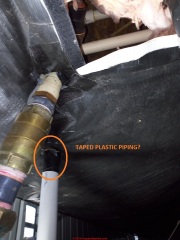 The incoming CPVC water pipe to my mobile home is bent (the insulation is off because the heat tape is being replaced.
The incoming CPVC water pipe to my mobile home is bent (the insulation is off because the heat tape is being replaced.
There are no leaks. When I push on it, it feels as if the CPVC pipe has now conformed to the bend.
There was a wire around it, over the old insulation, pulling it a little straighter, but I don't think it straightened it up very much.
[Click to enlarge any image]
It has probably been this way since the mobile home was set up, about 13 years ago. Is this something I need to be concerned about?
If so, how does it need to be fixed? I also would like to thank you for the guidance you provide via email and you website.
- Anonymous by private email 2020/02/25
Reply:
Anon:
Black electrical tape wrapped around some of the CPVC pipes may have been an effort to seal insulation against air leaks; if the tape is over pipe joints it may be an amateur and unreliable attempt to repair leaks.
I can't say that I see for-sure problems with your CPVC piping - it looks fairly straight - but in your photos that I attach with some annotations I've marked some possible trouble-indicators in orange.
My principal concern would be stress due to bending forces at the PVC pipe joints that might cause a leak; or of course though less-likely, extreme bending forces on PVC water or drain pipes could cause an actual break.
If sealant has been added at those pipe joints that might hint that the joints were stressed by bending and that someone attempted to repair leaks there - not in my opinion entirely reliable.
The black ABS pipe (above), in contrast, is quite commonly bent or curved and is more-flexible. That's not a worry.
Look closely at those joints where glue or sealant may have been added - if you see that the pipe is at an angle in the fitting or that the fitting is cracked or that there are drip or stain marks from prior leaks then I'd have a plumber re-make those joint now, before one breaks and gives trouble in the middle of the night.
On 2019-12-11 - by (mod) - plumbing access in a mobile home
No, Pugh but typically once we have to cut an access opening it makes sense to restore the wall or ceiling later with a removable panel so that future repairs will be easier and less costly.
On 2019-12-10 by Pugh
Does plumbing code require ease of access to replace a bathtub faucet? I have one enclosed behind cabinets and the air handling unit? Will cost tear out cabinets, cut access in wall, replace faucet, cover access hole and reinstall cabinets. Mississippi
On 2019-03-29 by (mod) - smell gas in my trailer home, don't know where gas lines run
Sharon
If your trailer has LP gas or natural gas supplied as a fuel for heaters or stove or water heater
Watch out: And you smell gas
GET OUT immediately and get help turning off the gas supply..
DO NOT do anything that makes a spark like flipping a light switch, using a phone in the trailer, etc.
There could be a gas explosion.
On 2019-03- by Sharon mcgowen
Did floor in kitchen and smell gas since can I find bluerints for trailer
On 2018-05-20 by (mod) - 1969 mobile home toilet overflowing then overflowed into the bathtub
Ashley
With just the information in your comment I can't make a thorough assessment of the repair that was done or comment on your land owner's work.
However if after their repair your drains were no longer clogged and you haven't had further backups it's possible that what they did was exactly what was required. So if you had a problem with a frozen drain you want to investigate that find out why in order to make sure it doesn't happen again
. For example if the skirting under a home falls off then cold drafts because the pipe to freeze even though it didn't happen previously.
On 2018-05-19 by Ashley
I have a 1969 mobile home. I bought it 10 years ago but last year I had a problem with my toilet overflowing then overflowed into the bathtub. When I ran my washer it made it worse. So I contacted the landowner he gave me a 25 foot snake to use.
It didn't help. So he came over with a friend and they replaced the black pipe with a pvc pipe. He told me that the septic was working fine and told me it was caused by a frozen sewer line under the house that was clogged or improperly set up so they had to replace the whOle main sewer line. This happen in winter by the way. But I went 9 years not having this problem. So I'm wondering if he was right or if he screwed me over??
On 2018-02-06 by (mod) - trouble with frozen pipes in mobile home
Judy,
I'm sorry that you're having trouble with frozen pipes and I understand the frustrations involved. Unfortunately it's not something that I can solve by text discussion. What we need is someone at your home to follow all of your water supply pipes to find the cold spots that are freezing.
Typically we solve that problem by blocking drafts, adding insulation, or sometimes adding a little bit of heat from the heat tape or even a light bulb. Perhaps your plumber would be willing to follow your pipes for you to help find the cold spot.
Search InspectApedia.com for "freezeproofing" to find
PIPE FREEZE PROTECTION - home https://inspectapedia.com/plumbing/Pipe_Freeze_Protection.php
On 2018-02-06 by Judy
PL some 1help us
This is the 2time my pipe are frozen again 1time 2week no water no they giving us more store I live in Sterling's a state no will help us
On 2017-06-02 by (mod) -
June Anon: see CLOGGED DRAIN DIAGNOSIS & REPAIR at https://inspectapedia.com/plumbing/Drain_Clog_Diagnosis.php
Feb How: sorry I don't understand the question - are you asking about water supply pipe location, routing, support ?
On 2017-06-02 by (mod) - What is pvc pipe behind trailer in the ground
Anon
Without seeing your home and following pipes that head in the direction of what you are seeing, and without knowing the pipe diameter I can only GUESS that you are seeing an access pipe or vent for a sewage line. There could also be an access opening to give cleanout to an area drain or buried roof drain.
See if you can look under your trailer to see a similar size and color drain pipe entering the ground and heading in that direction. Let me know what you see. You can also use the page bottom CONTACT link to send me some photos.
On 2017-06-02 by Anon
What is pvc pipe behind trailer in the ground with water always standing in it for??
On 2017-02-16 by How do the water lines run
How r the water lines run
On 2015-06-20 by Anonymous
cant find plumbing clog up
Question: (Dec 29, 2011) kenneth said:
how do i hook water to a mobile home that i set up on my farm from the well and the deep pump that i already have supplying water to the farm house
can i just T into that line with a check valve and run the line to the mobile home
were i have put another presure tank and wire the low presure switch to the pump on a switch at the pump so that if the farm house calls for water at the same time that it will just trip the breaker instead of over loading the pump with electricty
Reply:
Kenneth if the mobile home is close to the main building, you can run a water supply line teed off of the in-building cold water supply line in the main building right over to the mobile home. If you live in an area of freezing weather, however, you'll need to worry about burying the line to protect from frost.
For greater distances, say 100feet or more, you may want to install a second pressure tank and booster pump to deliver decent pressure and flow at the second home.
Question: how to prevent frozen pipes below a mobile home, doublewide, or manufactured home
(Aug 16, 2012) Michael said:
does a pressure tank underneath a double wide with vinyl skirting need to be insulated.
would building a 'box' around it with rigid styrofoam insulation be agood idea?
why dont they just put the pressure tank inside the heated space
Reply:
In prolonged cold weather even an insulated box won't prevent freezing pipes or a frozen water tank, but if you insulate the skirt (and possibly the ground surface) and add even a small heat source that may work find.
Question: what kind of plumbing vent is commonly used on "manufactured homes"?
(Jan 11, 2013) dar said:
Hello my question is what kind of plumbing vent is commonly used on "manufactured homes"?
Thank you
Reply:
Currently manufactured homes usually use plastic or PVC piping for plumbing vents but copper may still be found at some installations.
Question: kitchen sink doesn't drain
(Feb 6, 2013) dena said:
we are having trouble with the drainage from the kitchen sink
on a 1999 redman double wide mobile home underneath all is covered with plastic
does it have a clean out plug on the ends of the plumbing? i sure don't want to tear out
all the plastic put a 30 foot down the drain and didn't find nothin
Reply:
Dena take a look at BLOCKED DRAIN REPAIR METHODS and let me know if questions remain.
Question: hard water and poor pressure
(July 1, 2014) Angie said:
We have really hard water our cold water either has no pressure or the lines are blocked how can you check?
Reply:
Angie, start by checking the pressure gauge right at the pressure tank or water meter.
Then see WATER SOFTENERS & CONDITIONERS
and
WATER PRESSURE LOSS DIAGNOSIS & REPAIR - home
Question: leak under mobile home: stop-gap repairs
(Aug 10, 2014) Anonymous said:
I had a plumber come out this morning, I had a leak under my mobile home. He did not have the part to fix it and said he could cap off the main bathroom, so I would have water to the rest of the house. He capped it and now I only have hot water and he can't figure out why. He said something about a T, but can't find where it would hook into. This is a big name company. Any help out there?
Reply:
Anon
Your plumber might have to go to the trouble of crawling into the space below the home (get him some knee pads and maybe he'll get to work). There he may need to move insulation aside or temporarily remove a rat-screen to get access to and follow the piping to find where repairs are needed.
Question: OK to leave water turned off: 2007 Clayton S/W Mobile Home
(Nov 28, 2014) Debra said:
I have a 2007 clayton s/w mobile that was only occupied for one year. After that the water was turned off and it has been sitting for close to 3 years. Just wondering if this would be harmful to the water connections,since there was no heat in the mobile during the winter months.
Reply:
Debra
If the plumbing was not drained and if you were in a freezing climate you'd want to look out for leaks.
Beyond that, flush out or have a plumber sanitize the
water supply piping.
(Nov 28, 2014) Debra said:
I had drained all the water lines before the winter as soon as the water was cutoff. The only reason I asked about damage to the plumbing was because under the kitchen sink, both of the plastic nuts that hold the pex lines up to the fixture were cracked. I replaced them,and checked the ones under the bathroom sink,which were not damaged.Since,it is so difficult to get to all the supply lines I was unable to check any further.
Reply:
In cases such as the one you describe, people might try turning on the water but be sure to check everywhere, starting below the unit, immediately to see if there is leakage.
...
Continue reading at MOBILE HOME WATER HEATERS or select a topic from the closely-related articles below, or see the complete ARTICLE INDEX.
Or see these
Recommended Articles
- MOBILE HOME CODES, STANDARDS & MANUALS
- MOBILE HOMES, DOUBLEWIDES, TRAILERS - home
- MOBILE HOME FIRE SAFETY
- MOBILE HOME HEATING SYSTEMS
- MOBILE HOME LEAKS & MOISTURE
- MOBILE HOME WATER HEATERS
Suggested citation for this web page
MOBILE HOME PLUMBING at InspectApedia.com - online encyclopedia of building & environmental inspection, testing, diagnosis, repair, & problem prevention advice.
Or see this
INDEX to RELATED ARTICLES: ARTICLE INDEX to MANUFACTURED & MOBILE HOMES
Or use the SEARCH BOX found below to Ask a Question or Search InspectApedia
Ask a Question or Search InspectApedia
Try the search box just below, or if you prefer, post a question or comment in the Comments box below and we will respond promptly.
Search the InspectApedia website
Note: appearance of your Comment below may be delayed: if your comment contains an image, photograph, web link, or text that looks to the software as if it might be a web link, your posting will appear after it has been approved by a moderator. Apologies for the delay.
Only one image can be added per comment but you can post as many comments, and therefore images, as you like.
You will not receive a notification when a response to your question has been posted.
Please bookmark this page to make it easy for you to check back for our response.
IF above you see "Comment Form is loading comments..." then COMMENT BOX - countable.ca / bawkbox.com IS NOT WORKING.
In any case you are welcome to send an email directly to us at InspectApedia.com at editor@inspectApedia.com
We'll reply to you directly. Please help us help you by noting, in your email, the URL of the InspectApedia page where you wanted to comment.
Citations & References
In addition to any citations in the article above, a full list is available on request.
- [5] "Modular Home Construction, special defects and inspection methods" Dan Friedman, NY Metro ASHI Seminar, Holiday Inn, Crowne Plaza, White Plains NY, October 4, 1996
- [9] New York State: "Manufactured Homes: an installation guide for the code enforcement official," undated. [Div. of Code Enforcement & Admin. - 518-474-4073, George E. Clark, Jr., Director] - this is a guide tool, not an enforcement code or standard.
- [14] Mobile Home Inspection Checklist, Florida, Town of Lady Lake Building Department
- [15] Thanks to home inspector Peter Bennett for eagle-eye editing assistance regarding spelling at this web article series. Little Silver, NJ 07739 Office 732-758-9887 Fax 732-758-8993 Cell 732-245-9817 afullhouseinspectionco@gmail.com
- ABS Plastic Drain/Waste/Vent (DWV) pipe failures: reported for Centaur, Phoenix, Polaris, Gable, and Spartan pipe mfgs. for pipe made betweeen 1985 and 1988. CPSC Hot Line: 800-638-8270 or ABS Drain Leaks/Failures-Class Action Settlement COX settlement through Shell Oil set up by a contractor involved in the settlementPolubutylene Plumbing Failures: Spencer Class settlement. 10% of replacement cost/damages, only for acetal (plastic)fittings - /ag.arizona.edu/AZWATER/awr/nov94/leaks.html - Polybutylene plumbing info at U. Arizona Polybutylene piping lawsuit settlement website Polybutylene plumbing lawsuit proposed settlement-old site
- In addition to citations & references found in this article, see the research citations given at the end of the related articles found at our suggested
CONTINUE READING or RECOMMENDED ARTICLES.
- Carson, Dunlop & Associates Ltd., 120 Carlton Street Suite 407, Toronto ON M5A 4K2. Tel: (416) 964-9415 1-800-268-7070 Email: info@carsondunlop.com. Alan Carson is a past president of ASHI, the American Society of Home Inspectors.
Thanks to Alan Carson and Bob Dunlop, for permission for InspectAPedia to use text excerpts from The HOME REFERENCE BOOK - the Encyclopedia of Homes and to use illustrations from The ILLUSTRATED HOME .
Carson Dunlop Associates provides extensive home inspection education and report writing material. In gratitude we provide links to tsome Carson Dunlop Associates products and services.


